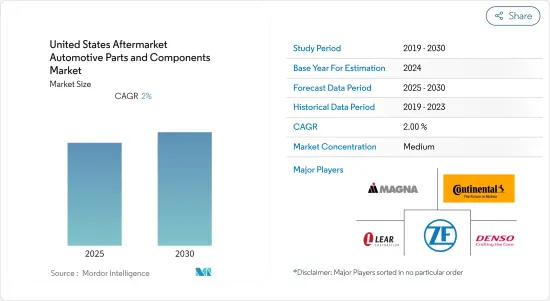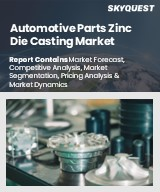
|
시장보고서
상품코드
1689685
미국의 애프터마켓 자동차 부품 : 시장 점유율 분석, 산업 동향, 성장 예측(2025-2030년)United States Aftermarket Automotive Parts & Components - Market Share Analysis, Industry Trends & Statistics, Growth Forecasts (2025 - 2030) |
||||||
미국의 애프터마켓 자동차 부품 시장은 예측 기간 동안 CAGR 2%를 나타낼 것으로 전망됩니다.

COVID-19 팬데믹이 미국의 애프터마켓 자동차 시장에 미치는 영향은 심각하며, 이는 세계 각국의 정부에 의한 잠그기 및 여행 제한으로 인해 제조업에서 여러 생산 중단으로 인한 것입니다. 자동차 산업 전체공급망이 혼란스러워 시장에서 자동차 부품 및 부품의 생산에 영향을 미쳤습니다.
그러나 자동차 부품 제조 수요는 자동차 제조업체의 성과에 직결되고 있으며 자동차 제조업체는 산업 제품의 가장 큰 구매자이기 때문에 시장은 안정적인 성장이 예상됩니다. 정품 교환 부품의 장점은 미국의 애프터마켓 자동차 부품의 성장을 가속하는 주요 요인 중 하나입니다. 전자상거래 플랫폼에서 자동차 부품을 쉽게 이용할 수 있는 것은 미국의 주요 애프터마켓 동향 중 하나입니다.
자동차 애프터마켓 산업에서의 3D 프린팅의 상승과 하이브리드 자동차 및 전 전기자동차에 대한 수요 증가는 예측 기간 동안 시장 성장을 더욱 밀어올릴 가능성이 높습니다. 또한 중고차 판매 증가는 미국의 애프터마켓 자동차 부품 시장에서 사업을 전개하는 주요 기업에 많은 기회를 창출할 가능성이 높습니다.
미국의 애프터마켓 자동차 부품 시장 동향
자동차 애프터마켓 부품의 온라인 판매 증가
미국의 애프터마켓 자동차 부품 시장은 사람들의 온라인 활동 증가로 낙관적인 성장을 이룰 것으로 예측되고 있습니다.
세계의 COVID-19 팬데믹에도 불구하고, 자동차 애프터마켓은 2020년에 예상을 웃도는 실적으로 다시 회복력을 나타냈습니다. 미국의 소형차 애프터마켓 전체의 매출은 2021년에는 약 11.2% 증가한 3,250억 달러에 달했습니다. 2021년에는 코로나바이러스의 유행에 따라 전자상거래 활동은 30% 증가로 급증했습니다.
자동차 부품과 부품의 온라인 쇼핑이 늘어나고 있습니다. 자동차 기술의 변화에 따라 더 많은 하이브리드 자동차와 전기자동차가 시장에 진입하고 미국의 애프터마켓 자동차 부품 시장 성장을 가속하고 있습니다.
시장에 영향을 줄 것 같은 전기차 판매 증가
전기자동차 시장은 해마다 증가하고 있으며 자동차 산업의 성장에 영향을 미치고 있습니다. 미국의 플러그인 전기자동차의 연간 판매량은 2021년에는 17만 2,100대를 넘어 이 시장의 요구에 대응하는 부품 구성 요소에 대한 수요가 높다는 것을 보여주었습니다. 또한 미국은 북미에서 가장 큰 플러그인 하이브리드 자동차 제조업체입니다. 이 나라는 카딜락, GMC, 테슬라, 크라이슬러 등의 제조업체들이 시장을 선도하는 이들 자동차의 최대 시장이기도 합니다.
자동차 산업의 e-모빌리티로의 지속적인 변화로 인해 미국에서는 지난 몇 년간 플러그인 전기자동차 판매가 증가하고 있습니다. 기존의 파워트레인 차량에는 2,000개 이상의 부품이 탑재되어 있지만, 전기자동차에는 훨씬 적은 부품만 탑재되어 있습니다. 예를 들어, Tesla가 밝힌 바에 따르면, 드라이브 트레인의 가동 부품은 2개의 모터를 포함하여 17개만 있다고 합니다. 드라이브 트레인은 전기자동차의 심장부이기 때문에 자동차 부품 제조업체는 먼저 관련 부품 제조로 시작할 것으로 예상됩니다. 또한 자동차 부품 제조에 종사하는 미국 직원 59만명 중 15만명 가까이 내연기관(ICE)용 부품 제조에 종사하고 있는 것으로 추정됩니다.
이 수는 기업이 그 일부를 EV 부품이나 구성 요소의 제조에 채우기 때문에 예측 기간 중에 변화할 것으로 예상됩니다. 전력 인버터, DC-DC 컨버터, 배터리 및 관련 부품, 모터 제어 유닛(MCU) 등은 시장에서 관련성을 유지하기 위해 기업이 장기적으로 제조하는 기타 중요한 부품의 일부입니다. EV 관련 예비 부품의 애프터마켓 부문에서의 채용은 당초 늦게 진행되지는 않지만, 산업이 패러다임 변화를 맞이하고 있기 때문에 수년 후에는 상당히 확대될 것으로 예상됩니다.
미국의 애프터마켓 자동차 부품 산업 개요
미국의 애프터마켓 자동차 부품 구성 요소는 주요 Tier1 및 Tier2 부품 제조업체의 존재와 다수의 조직되지 않은 엔터프라이즈 기업의 존재로 인해 통합 및 부문화되지 않았습니다. 진출기업은 시장 점유율을 얻기 위해 다른 주요 기업과 제휴하고 있습니다. 예를 들어, 2022년 3월 Meritor는 ConMet과의 협업 계약을 통해 맞춤형 트레일러 서스펜션과 브레이크, 타이어 공기 주입 시스템을 개발하여 ConMet의 프리셋 플러스 이허브와 협력하여 무공해 냉장 트레일러를 생산할 수 있도록 하겠다고 발표했습니다.
기타 혜택
- 엑셀 형식 시장 예측(ME) 시트
- 3개월간의 애널리스트 서포트
목차
제1장 서론
- 조사의 전제조건
- 조사 범위
제2장 조사 방법
제3장 주요 요약
제4장 시장 역학
- 시장 성장 촉진요인
- 시장 성장 억제요인
- 산업의 매력 - 포터 Five Forces
- 신규 참가업체의 위협
- 구매자·소비자의 협상력
- 공급기업의 협상력
- 대체품의 위협
- 경쟁의 강도
제5장 시장 세분화
- 자동차 유형
- 승용차
- 상용차
- 용도
- 엔진 부품
- 변속기
- 내부
- 외관
- 기타
- 판매 채널
- 온라인
- 오프라인
제6장 경쟁 구도
- 공급업체의 시장 점유율
- 기업 프로파일
- Magna International Inc.
- Continental AG
- ZF Friedrichshafen AG
- DENSO Corporation
- Robert Bosch GmbH
- Lear Corporation
- Flex-N-Gate Corporation
- Panasonic Automotive Systems Company of America
- Aisin World Corp. of America
- American Axle & Manufacturing Holdings Inc.
- Yazaki North America Inc.
- Adient PLC
- Faurecia
- Aptiv PLC
제7장 시장 기회와 앞으로의 동향
KTH 25.05.12The United States Aftermarket Automotive Parts & Components Market is expected to register a CAGR of 2% during the forecast period.

The impact of the COVID-19 pandemic on the US aftermarket automotive market was severe, and this can be attributed to several productions halts in the manufacturing industry due to lockdowns and travel restrictions imposed by governments across the world. The supply chain of the entire automotive industry is disrupted, impacting the production of automotive parts and components in the market.
However, the market is expected to have steady growth as demand for auto parts manufacturing is directly related to the performance of automakers, as they are the largest purchasers of industry products. The advantages of original replacement parts are one of the primary factors driving the growth of the automotive parts aftermarket in the US. The increasing availability of automotive parts on e-commerce platforms is one of the major aftermarket trends in the United States.
The emergence of 3D printing in the automotive aftermarket industry and the growing demand for hybrid and all-electric vehicles are likely to further boost the market growth during the forecast period. Furthermore, the rise in the sales of used cars is likely to create numerous opportunities for the key players operating in the US aftermarket automotive parts and components market.
USA Aftermarket Automotive Parts & Components Market Trends
Rising Online Aftermarket Automotive Parts and Components Sales
The US aftermarket automotive parts and components market is projected to have optimistic growth due to increased online activities by people. Advancement in technology, coupled with rapid improvement in logistics, has allowed manufacturers to offer high-quality goods faster and further boosts the growth of the market. E-commerce activities grow at a higher rate than the forecast rate due to the ongoing pandemic.
Despite the global COVID-19 pandemic, the automotive aftermarket once again demonstrated its resilience in 2020 with a greater-than-anticipated performance. The industry rebounded strongly in 2021. It is estimated that the overall light-duty vehicle aftermarket sales in the United States will rise around 11.2% to USD 325 billion in 2021. In general, the growth rate of online parts sales has historically been about 16% per year, but in 2021, due to the coronavirus pandemic, e-Commerce activities surged to a 30% increase. This includes replacement parts, aftermarket parts, and accessories. Thus, this pandemic has created lucrative opportunities for the major players in the market during the forecast period.
Automotive parts and components online shopping is growing. As automotive technology is changing, more hybrids and electric vehicles are entering the market, boosting the growth of the US aftermarket automotive parts and components market. In addition, mobile shopping is on the rise, and online platforms like Amazon and eBay are likely to influence the US online aftermarket automotive parts and components market.
Increasing Electric Vehicle Sales Likely to Impact Market
The market for electric vehicles is increasing year on year, impacting the growth of the automotive industry. The annual sales of plug-in electric vehicles in the United States crossed 172.1 thousand units in 2021, indicating the high demand for parts and components to cater to the needs of this market. In addition, the United States is the largest manufacturer of plug-in hybrid vehicles in the North American region. The country is also the largest market for these vehicles, with manufacturers such as Cadillac, GMC, Tesla, and Chrysler, leading the market.
With the automobile industry's continuous shift towards e-mobility, the sale of plug-in electric vehicles has been increasing in the United States for the past few years. While conventional powertrain vehicles have more than 2,000 components within them, electric vehicles have far fewer. For instance, Tesla revealed that in its drivetrain, there are only 17 moving parts, including two in the motor. Since the drivetrain is the heart of any electric vehicle, it is expected that automotive component manufacturers will first start with their associated part manufacturing. Also, it is estimated that out of the 590,000 U.S. employees engaged in auto parts manufacturing, nearly 150,000 are in component manufacturing for Internal Combustion Engines (ICE).
This number is expected to change over the forecast period as companies will dedicate some of them toward EV parts and component production. Power Inverters, DC-DC Converters, Battery & related parts, and Motor Control Units (MCU) are some of the other important parts that will also be manufactured by companies over time to stay relevant in the market. The adoption of EV-related spare parts will be slow in the after-market space initially, but with the industry seeing a paradigm shift, the rate is expected to grow considerably after some years.
USA Aftermarket Automotive Parts & Components Industry Overview
The US aftermarket automotive parts and components market is neither consolidated nor fragmented due to the presence of major tier-1 and tier-2 component manufacturers and a large number of unorganized players in the market. Companies are focusing on marketing their products and tying up with local dealers to garner more market share. Some of the major players in the market include Magna International Inc., Continental AG, ZF Friedrichshafen AG, DENSO Corporation, and Lear Corporation. Players are partnering with other key players to gain market share. For instance, in March 2022, Meritor, Inc. announced a collaboration agreement with ConMet under which Meritor will develop custom trailer suspensions and brakes, as well as tire inflation systems, to work with ConMet's PreSet Plus eHub to enable the production of zero-emissions refrigerated trailers. Meritor is redesigning its trailer suspension and drum brake, as well as a specially engineered spindle package to be compatible with ConMet's eHub, to deliver this electrified trailer solution. The companies will also continue to evaluate the application of complementary advanced technologies that address evolving e-mobility market trends in collaboration.
Additional Benefits:
- The market estimate (ME) sheet in Excel format
- 3 months of analyst support
TABLE OF CONTENTS
1 INTRODUCTION
- 1.1 Study Assumptions
- 1.2 Scope of the Study
2 RESEARCH METHODOLOGY
3 EXECUTIVE SUMMARY
4 MARKET DYNAMICS
- 4.1 Market Drivers
- 4.2 Market Restraints
- 4.3 Industry Attractiveness - Porter Five Forces
- 4.3.1 Threat of New Entrants
- 4.3.2 Bargaining Power of Buyers/Consumers
- 4.3.3 Bargaining Power of Suppliers
- 4.3.4 Threat of Substitute Products
- 4.3.5 Intensity of Competitive Rivalry
5 MARKET SEGMENTATION (Market Size in USD Billion)
- 5.1 Vehicle Type
- 5.1.1 Passenger Cars
- 5.1.2 Commercial Vehicles
- 5.2 Application
- 5.2.1 Engine Components
- 5.2.2 Transmission
- 5.2.3 Interior
- 5.2.4 Exterior
- 5.2.5 Other Applications
- 5.3 Sales Channel
- 5.3.1 Online
- 5.3.2 Offline
6 COMPETITIVE LANDSCAPE
- 6.1 Vendor Market Share
- 6.2 Company Profiles
- 6.2.1 Magna International Inc.
- 6.2.2 Continental AG
- 6.2.3 ZF Friedrichshafen AG
- 6.2.4 DENSO Corporation
- 6.2.5 Robert Bosch GmbH
- 6.2.6 Lear Corporation
- 6.2.7 Flex-N-Gate Corporation
- 6.2.8 Panasonic Automotive Systems Company of America
- 6.2.9 Aisin World Corp. of America
- 6.2.10 American Axle & Manufacturing Holdings Inc.
- 6.2.11 Yazaki North America Inc.
- 6.2.12 Adient PLC
- 6.2.13 Faurecia
- 6.2.14 Aptiv PLC



















